If you can't imagine a purposeless walk from one strip mall to another being beautiful, spend two hours in the Diefenbunker.
By Mark Fenton
Published October 01, 2010
In order to investigate the subtleties of art, he set himself one day to make his own portrait, looking at himself in a convex barber's mirror. 1
--Giorgio Vasari on Parmigianino's Self-Portrait in a Convex Mirror
Wherever I travel I try to get a picture of myself in a convex mirror. Over the summer I collected a series of pictures in convex mirrors, and I'd like to share them with you.
Despite having lived in Hamilton since 1991, I made my first trip to Mississauga this past July. When I say it was my first trip to Mississauga, I'm not including trips to Lester B. Pearson International Airport which is technically in Mississauga but which I don't believe represents Mississauga culture any more than any airport represents the culture of the municipality it's in. 2
I had gone into Mississauga to pick up our order for the Ontario Natural Food Co-op 3 As I stood waiting for the order, I discovered, on the truck parked next to my car, a mirror of such semi-spherical chrome perfection it would have thrilled Parmigianino. So I crouched and took a picture of myself.
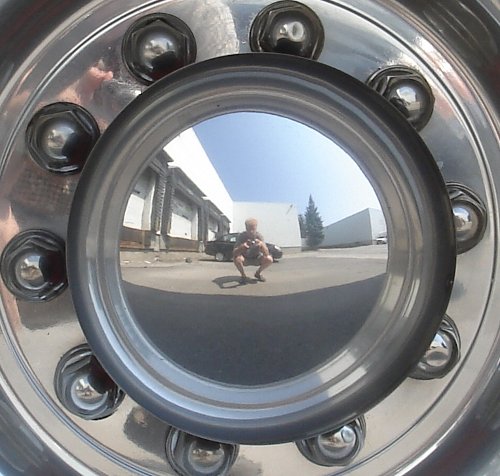
A moment later a lovely woman I can only assume was the truck-driver, darted under the trailer
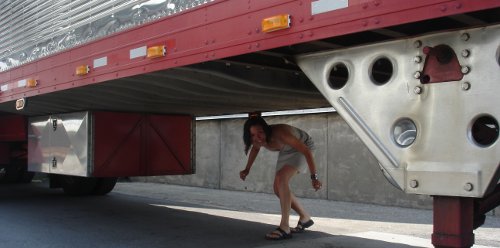
to investigate what I might be doing to her rig. 4
The best thing about going to pick up food orders at ONFC these past few months is that given the heat of the 2010 summer in the Golden Horseshoe and the fact that our air-conditioning at home is challenged, the ONFC warehouse itself is kept very, very cold, and I could sort of lean over the loading dock and take in some of the cool, in the process being nearly run over by this ONFC employee.
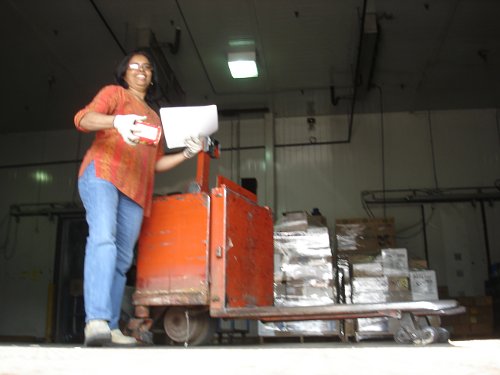
I don't know her name, but she has the words BOMBAY QUEEN written on the front of her forklift with a black marker. Even though she doesn't really require the power of a forklift to transport the item that's been missed from the order (i.e. the item holding it in her hand) she's used the speed of her machine to go and get it. She moves on that thing like Tony Hawk moves on a skateboard, and, I might add, without wearing anything as uncool as protective headwear.
I meant to ask her if there is a race among fork lifters to land a 900, as there was in the skater world in the 1990s 5 but she had better things to do than gab with a fanboy. Really we should all make trips to watch people working at jobs that are utterly different from our own. At the end of day when we're elbowing past strangers to gain a few seconds in the 1-8 Items line at Fortinos and get dinner for the kids, I think it would increase empathy and admiration for the people we're elbowing past, and we might even not elbow past them but just let them go ahead and we'd both get chatting so intently about the unique challenges of our respective jobs that time in the line would seem to disappear.
Later this summer I encountered a convex mirror when I was a guest at the pre-event dinner for a fireworks competition in Ottawa. I often feel these images forecast how my being will shape and be shaped by events that are about to unfold (rather like a quick and easily interpreted I Ching reading.)
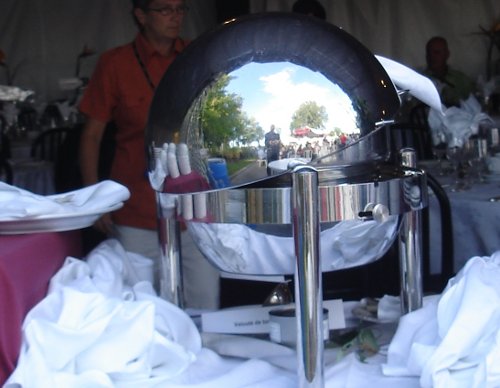
Here, I'm distorted into a man with a tiny head and uncharacteristically broad shoulders.
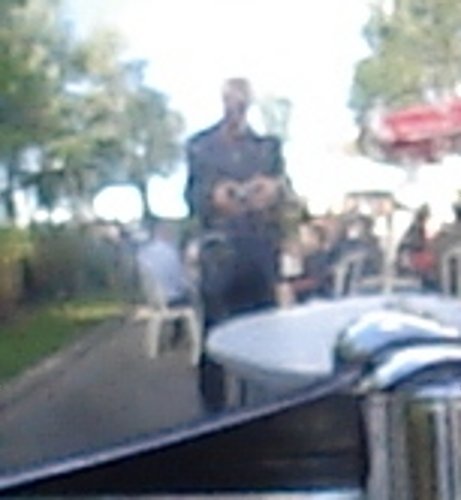
reminiscent of David Byrne's Big-White-Suit from the mid 80s,
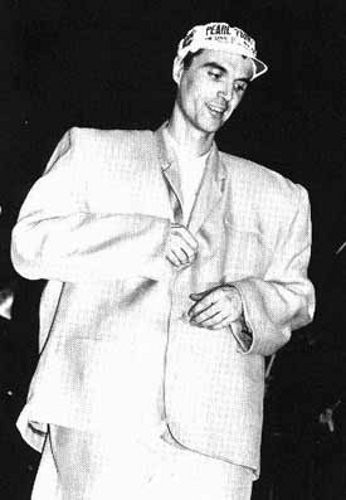
and as a prophecy for the evening I read it as a sign that I will be regarded as a mildly subversive pseudo-corporate presence. Later in the evening, from my V.I.P. seat, I snapped this photo of the fireworks themselves,
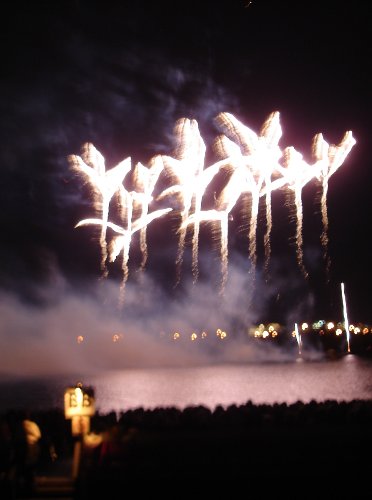
to looks of astonishment from my hosts. I was there on a press pass and I think my hosts were wondering if I was an impostor, since they surely expected a journalist to carry a less meagre camera, and what kind of photos did I think I was going to get shooting randomly into the night sky with that thing? (To interpret their response as it relates to my recent photo in the convex mirror, they were less struck by my broad shoulders than by my tiny head.)
That being said I don't think the definition my best photograph gave to the fireworks is markedly worse than James McNeil Whistler's depiction of London Fireworks, 6 in his famous "Nocturne in Black and Gold."
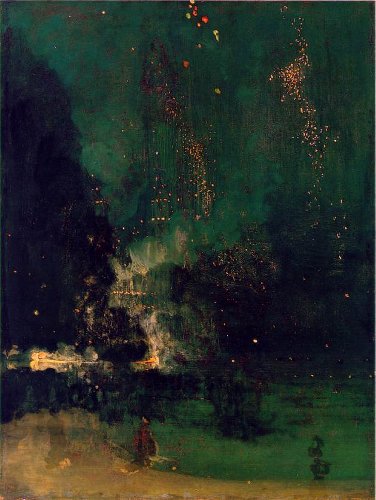
The fireworks were well done, though I have little enthusiasm for the art form. Before you even get to cost (monetary and environmental), explosions in the sky seem a strange entertainment in the wake of a half century of cold war terror.
The fireworks display was one of the few "events" from the week I spent in Ottawa this past August that wasn't simply a visit to a museum. Sadly I have little to say about all the time I spent in museums. Perhaps that simply means they all did the job of entertaining and educating people and that I find it hard to remark on things that function the way they're supposed to. 7
I think the fatigue that nearly all museum visitors experience has something to do with the institutional anonymity of the rooms, and the conflicting attempts to be friendly. I feel this even in the bite-sized wall-texts that attempt (and are of necessity doomed to fail) to communicate equally to six-year-olds, visitors with a PhD on the subject, and everyone in between. Then there's the disorienting sense of consuming a lengthy historical span (centuries or even millennia long) in an hour or two. 8
Add to that the design and directional signs of North American museums make us feel like failures if we don't run our eyes over every item in every exhibit (despite knowing full well that we can't appreciate everything in one visit and shouldn't try to) and by the end it's like running our tired eyes over information in a textbook that we don't absorb.
These paradoxes are described more profoundly, though with characteristic opacity, in a poem by John Ashbery called "Self-Portrait in a Convex Mirror"
Yet the "poetic," straw-coloured space
Of the long corridor that leads back to the painting,
Its darkening opposite-is this
Some figment of "art," not to be imagined
As real, let alone special? Hasn't it too its lair
In the present we are always escaping from
And falling back into, as the waterwheel of days
Pursues its uneventful even serene course?
I think it is trying to say it is today
And we must get out of it even as the public
Is pushing through the museum now so as to
Be out by closing time.
The most memorable museum experience I participated in, and interestingly the most un-museumlike, was the Diefenbunker/Cold War Museum located in the town of Carp. Here's the Carp coat of arms, mounted in the museum itself, depicting Cerberus the three headed dog that guards the gates of hell. 9
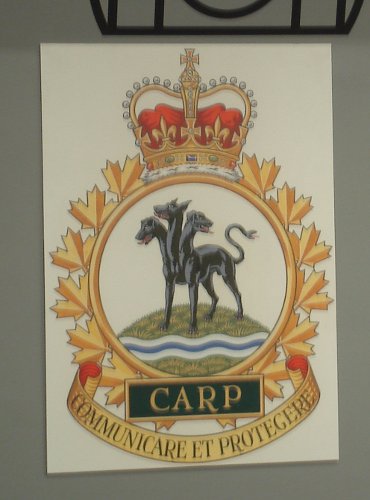
Diefenbunker is the popular name for Emergency Government Headquarters. The Diefenbunkers are series of bomb shelters built across Canada during the early years of the cold war. Their purpose was to receive the Prime Minister and other high ranking government officials in the event of a nuclear attack, and house them comfortably until radiation fell to acceptable levels. The Deifenbunkers were equipped with radio technology for officials to broadcast to whomever might be out there with a functioning radio, and tell these people that things were going to be OK. Eventually the officials could exit and continue to give public service to whomever had survived. The Diefenbunkers have, for the most part, been decommissioned. 10
The entrance leads to a 378 foot "blast tunnel" 11
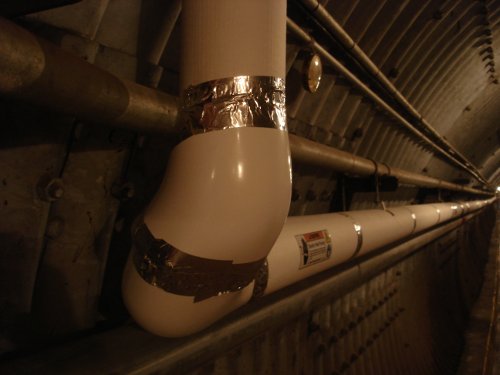
Think about it. It's not a very inviting gateway to the next year of your life, and everything outside is worse. Even cave dwellers in the formative years of homo sapiens painted pictures on the walls.
The tunnel deposits the visitor into the decontamination area. A person wandering through the apocalypse would be given three chances to shower and then be assessed for radiation with a Geiger counter. Failing it a third time, the person would be sent back out into the wasteland. Eric, our tour guide, here quips blandly that he's never determined whether the radiation assessors would be charitable enough to offer the poor soul the government-issue overalls to wear, or whether the person would be sent back outside in the buff. Eric's narrative is full of this uninflected, multi-clausal gallows humour, clearly scripted and delivered with a kind of semi-committed laboriousness, such that each time I feel he might run out of stamina before fully delivering the punch line.
Everything about Eric's presentation is the perfect metaphor for the utter futility of barricading people against nuclear fallout. The whole vibe of the bunker suggests a nation's whose heart isn't really in the idea of bomb shelters. And the consistently half-assed tone of the project is present also in it's museumization. It's the element that makes me proudest to be Canadian. Significantly Prime Minister Diefenbaker never visited the facility he's eponymous for and which was designed with him as the star guest.
Eric is absolutely the most laid back tour guide I've ever met and that includes the pro-skier at Laurier House (who, much as I loved his knowledge and style, emanated a type-B personality so letter perfect that it felt just a tiny bit studied.) Unlike any other museum I've been in, I was free to
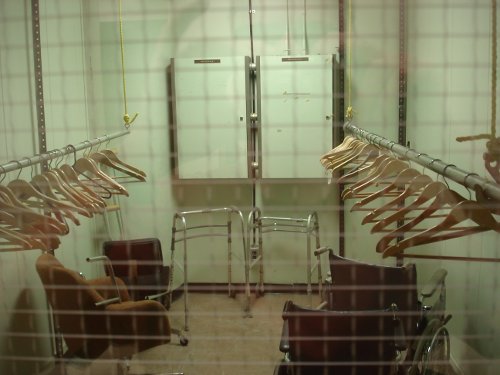
wander off and wander back, 12 and to open, on the merest whim, any doors that appealed to us
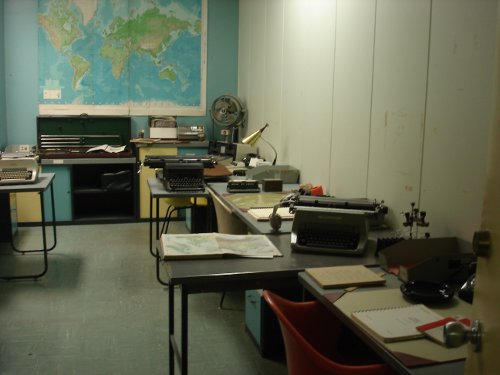
and to sit in any chairs (which is always an appealing option during a museum tour.) The implication of this approach is self-evident. Why not come and go as you please? We are all living in the moment because all continuity between one moment and another has been obliterated. All rooms are in the Deifenbunker are of equal importance and unimportance.
As Eric lead us through the conference room,
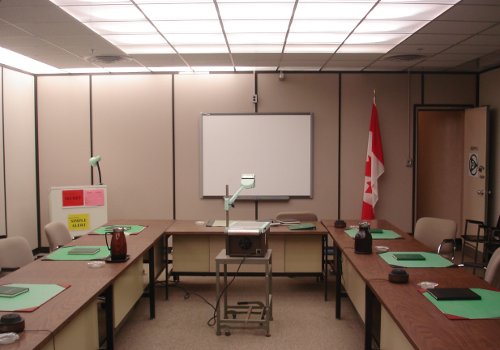
I was reminded of the final scene of Dr. Strangelove, where the Dr. and various strategists of the war room,
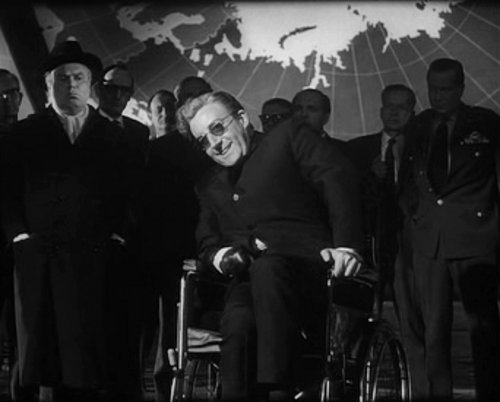
discuss the possibility of moving a core of high ranking politicians and military leaders to underground tunnels.
Dr. Strangelove: Of course it would be absolutely vital that our top government and military men be included to foster and impart the required principles of leadership and tradition. [...]Naturally, they would breed prodigiously, eh? There would be much time, and little to do. But... ah... with the proper breeding techniques and a ratio of say, ten females to each male, I would guess that they could then work their way back to the present gross national product within say, twenty years.
[...]
General Turgidson: Doctor, you mentioned the ratio of ten women to each man. Now, wouldn't that necessitate the abandonment of the so-called monogamous sexual relationship, I mean, as far as men were concerned?
Dr. Strangelove: Regrettably, yes. But it is, you know, a sacrifice required for the future of the human race. I hasten to add that since each man will be required to do prodigious... service along these lines, the women will have to be selected for their sexual characteristics which will have to be of a highly stimulating nature.
Eric might just be an offspring of this brave new world. He doesn't look to have spent any time in the sun, but he seems unconcerned without having experienced the green world above, since he's lived a life without memories of it. You'd hardly call him excited by his environment, but there's no indication that he wants to be anywhere else, or even knows of an 'anywhere else.'
I was compelled to ask what the VIP list for the bunker looked like and if it included ten or so fertile and tantalizing women for P.M.D. for just such a last ditch (literally again) plan and if so, had the list been declassified and could I please get a hold of it, and further, did DND ever stop to think that they might, for this primary duty, want to supply P.M.D.
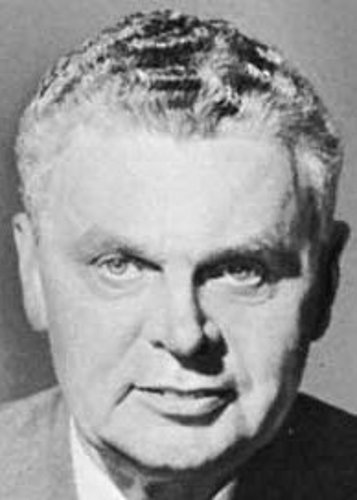
with a slightly more robust Diefenbed than this rickety army cot,
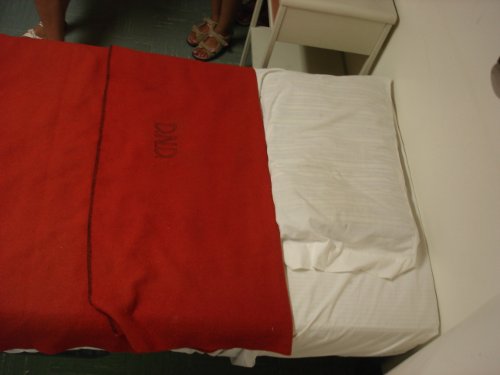
but the vibe of the people in the tour, many of whom were older than me and had obviously lived through the more jittery periods of the cold war, suggested this would put me even more on the outskirts of the tour than I already was.
Down this hall with its incongruous sports icons, Eric leads us lemminglike
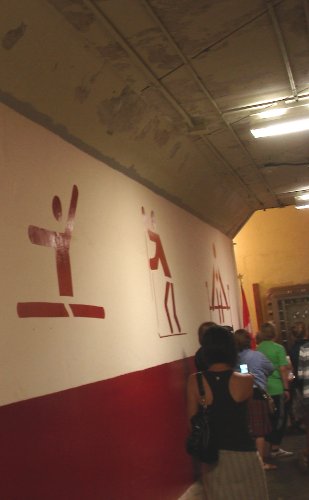
into to the Bank of Canada/Cold War Monument. 13 This is the dark heart of the bunker. For reasons that were explained to me but which I forget, it's about the same temperature as the ONFC warehouse (I suspect it's just really deep underground and there aren't heating ducts here).
In his Inferno, Dante buried the arch enemies Ugolino and Ruggieri in ice in the final circle of hell, with Ugolino sentenced to gnaw at Ruggieri's skull throughout eternity. When I eventually steel myself up to enter, that's what it feels like this room is for, and this association with Dante's most infamous duo of damned (I know, literally yet again!) badasses is as good a metaphor for the cold war arms race as I'll ever require.
This space was initially built as a treasury vault. The idea was that after radiation dropped to a safe level, P.M.D. (and, I guess, his pregnant women) could grab a few gold bars, surface, and go out and head out to the 1-8 Items line at Fortinos. It strikes me that the first guy he met above ground would be more likely be looking to trade his half eaten dog for an integral can of tomatoes, and have no use for gold bars, but obviously P.M.D.'s advisors understand post-nuclear commerce better than I do. 14
Now though it's become a cold war monument. Here's Eric explaining it.
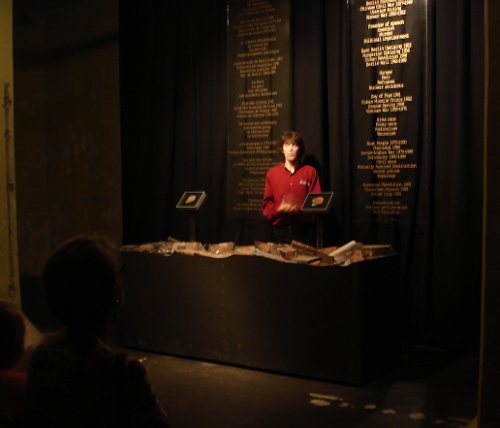
I can't get focus. It's incredibly dark here. I think the whole room is fitted for a single 40 watt bulb and that that's part of the concept. I'm finding it impossible to nail down the tone of this tour. Not only is there no sense of the tour rising to a climax; there's no sense of a tour. Imagine you've just landed a shift job as a security guard for an empty office building, and the guard appointed to take you around the building and train you on your first day is Eric. That's how I feel in here.
The proposal and construction of May Lin's groundbreaking Vietnam Memorial provoked controversy at the time for being a sunken absence rather than a commanding presence. 15 It consists simply of long stretches of dark wall, like the dark bar of a Barnett Newman, extending to infinity. The reflective surface functions as a mirror. A mirror with no distancing affect of concavity or convexity. Simply a stark, forced entanglement of the visitor with the names of the dead.
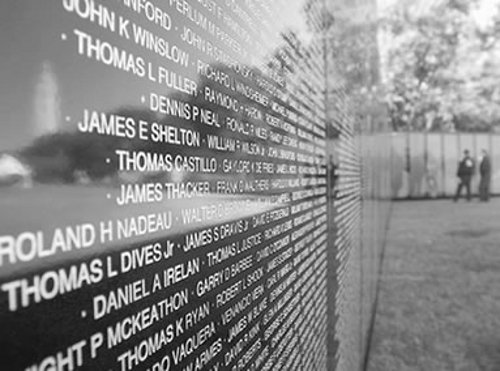
The Canadian Cold War Memorial goes one better by being not so much being stark, as being just a bunch of stuff dumped on a table.
The monument is a tray of rubble taken from cold war icons, Hiroshima, the Berlin Wall, etc. I don't sense the rubble is arranged in any particular order or pattern, or subject to any curatorial preservation stipulations. Eric is idly picking pieces up and dropping them back. He doesn't say we can come up and play with the stuff, but neither does he say we can't. (I wonder actually if you're allowed to take a stone and leave a stone, like you can with objects in a geo-cache.) I don't recall anyone going up there.
The words behind the altar are a correlative for the rubble.
Here's a sequence from of the list at random:
Hunger
Fear
Refugees
Nuclear Accidents
Bay of Pigs
Cuban Missile Crisis
Prague Spring
Vietnam War
Arms race
Proxy Wars
They look like the unedited results of a government brainstorming session where a team has been asked to shout out themes and events commonly associated with the cold war, and then they just had the words done up in gold and stuck on a dark wall.
I did not leave the Diefenbunker with a good energy. I attribute the rapid leak that the back tire of my car developed on the drive out of Carp as having been caused by malign energy from the structure below it (probably the Ugolino and Ruggieri room.) I was just barely able to drive it to a Canadian Tire in Kanata, which by some miracle I could see from the road. They diagnosed it as irreparable.
If you were a native of, say, Central Africa and were airlifted first to Mississauga and then to Kanata, you might be hard-pressed to distinguish between them. Normally I find the sameness of North American suburban sprawl disheartening. However, while I waited for my tire to be replaced, I strolled idly from one strip mall to another. After the Diefenbunker this little passageway from a parking lot, through a burst of greenery, and then into another parking lot exactly the same as the first, felt like a gateway back into Eden.
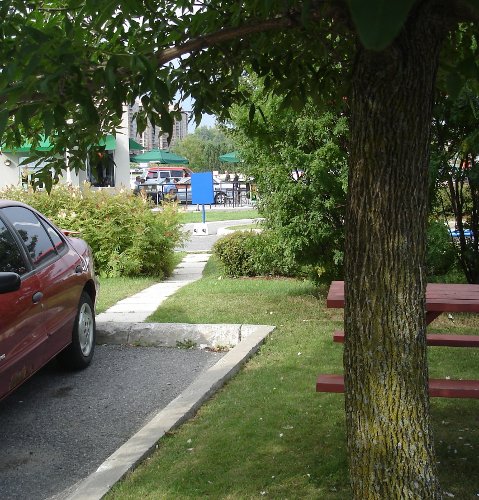
Or perhaps simply a passage from one Eden to another.
Has it occurred to anyone that the very fact that a nuclear war hasn't yet occurred might mean we haven't yet been expelled from Eden? If you can't imagine a purposeless walk from one strip mall to another being beautiful, spend two hours in the Diefenbunker.
Those, anyway, were my thoughts as I loitered in a convenience store/gas bar, reflecting on the nature of museums.
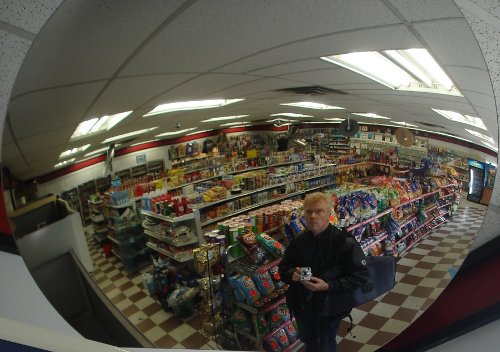
1. The work in question is an Italian mannerist painting that looks like this.

Vasari was a renaissance art critic who knew many of the great Italian masters and interspersed art criticism with matter-of-fact descriptions of artist's work methods, and mundane details about their lives. I like authors who are all over the place like that (though some readers prefer authors who chose a thesis and stick to it and those readers have already clicked out of this essay.)
I also like pictures reflected in convex mirrors, because they're all, of necessity, self-portraits. Like this photo of Samuel Beckett, by Henri Cartier Bresson,
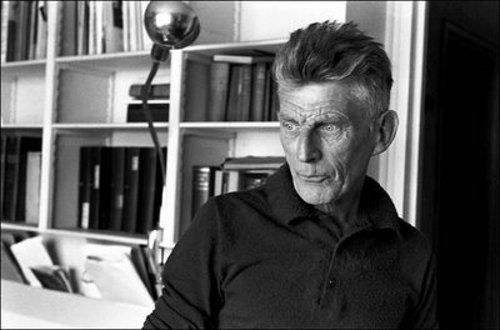
which for me isn't really a portrait of Beckett but a self-portrait of Cartier Bresson, who I can see slightly hunched, his face intruding into the left side of the rectangle of white light from what must be a window. Though I'll admit the portrait might not be overly useful if M. Cartier-Bresson was on the lam for, say, identity theft, and you were Commissaire Maigret and this photo was all the Chef de Police gave you to track the dastardly villain down.
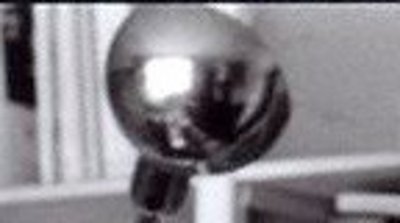
2. Of course I could be dead wrong here. Maybe it goes down like this.
Mississauga Tourist:So what's it like living in Mississauga?
Mississauga Native:It's not bad. It's great having the airport nearby. I guess you could say that's mostly were we go to hang out.
Mississauga Tourist: Really! What do you do there?
Mississauga Native: Well, there are a lot of overpriced restaurants, and lots of places to buy Tylenol and gum, and the people who work security clearance are fun to goof around with. And if you run into friends and you have a few days to kill you can fly somewhere. I always take my passport with me just in case.
Mississauga Tourist: Isn't it hard to get to?
Mississauga Native:Not at all. Sometimes I ride my bike. Mostly I just walk though.
Mississauga Tourist: Wow, do you ever run into people you know there?
Mississauga Native: All the time. I guess you could say it's the heart of the Mississauga community.
3. This is not product placement for ONFC. I don't receive any compensation for mentioning them and ONFC don't even know they're being mentioned. I don't actually receive any compensation for anything in these articles, but on the other hand they (the essays) don't cost me anything to write other than I think I once needed a photograph of a comb for an article I was working on and I went out and bought a comb (and then didn't end up using the photo). I have no idea who manufactured the comb and don't much care. I object to product placement on general principle, though now that ONFC has been mentioned three times (Damn! Four!) I'm starting to feel a bit peeved that I'm not getting something for the shout out.
4. This is a bare-faced lie. I have been married to the woman pictured in the accompanying photographed since 1991 and she doesn't have a licence to drive a car, let alone an 18 wheeler. For the record I'd say about 83 % of the events I describe are in all respects factually true, and the remaining 17% are true in the broad strokes but, perhaps, embellished a bit in the detail. A sentence like the above is a wild and shameful exception to my m.o. and I thought it only ethical to confess immediately.
5. If you don't follow skateboarding (which I've called "skating" here to try and emulate skater dude argot, and am just really coming off as a wannabe) the 900 is a stunt where you exit upward off the ramp, spin 2.5 times (900 degrees) and (here's the really really tense part) actually land on the board and don't touch the ground with your body and, obviously, don't wipe out completely and get rushed to hospital with multiple fractures. The first provable 900 (in the sense of being filmed from start to finish) was Tony Hawk at the 1999 X-Games. Watch it on YouTube.
6. John Ruskin, the Victorian art critic, was famously outraged by the painting and accused Whistler of extreme impudence at charging "two-hundred Guineas for flinging a pot of paint in the public's face." Whistler sued Ruskin for libel and was awarded damages of a farthing (and driven to bankruptcy by legal fees in the process.) It's a shame Jackson Pollock didn't sue LIFE magazine for entitling their feature on him "Jack the Dripper." My conversion chart says he might have been awarded as much as $0.04 in 1949 USD.
7. Here are some bullet points though, which, with the exception of one museum that insisted on blasting itself out of Footnote 7, gets my Ottawa museum experience out of the way in as few words as possible.
The tour guide at the Laurier house, whose knowledge of both Laurier's and McKenzie-King's tenure in the house was breathtakingly exhaustive and compelling, was also a pro-skier and spoke in a hyper-relaxed vernacular English punctuated regularly by word "dude," and employing a lot of high rising terminals. His whole manner and look, including shoulder-length hair and a lavish tattoo emerging from beneath the short sleeve of his Government of Canada uniform was, in relation to the Prime Ministers he was describing, so far beyond incongruous that the word surreal doesn't really begin to do it justice. (Why is it that skiers, surfers, snow-boarders and skater dudes everywhere default to the same Southern California slacker dialect? While they all engage in dangerous, fast paced, solo-sports activities that demand a near religious devotion to lifestyle and attitude, all of aforementioned activities, of necessity, take place in regions radically different from each other. There shouldn't be that much cultural sharing. I suppose the short answer is that in the information age culture is no longer governed by physical location and climate.)
I overheard a tour guide at the Museum of Civilization - a man who spoke English as a second language - addressing a group of young Asian women who were in school uniforms and who I think it can be safely assumed spoke English a second language. The historical item being presented was the intermarriage of early Quebec Habitants and Aboriginal Canadians, and I was deeply curious to know a) to what extent any of this information was actually getting communicated and b) how this information would be brought alive to friends and family and teachers when the visitors travelled the 6,000+ nautical miles home. They didn't ask a lot of questions.
I overheard a tour guide at National Gallery of Canada-you can tell I prefer eavesdropping on tours to actually participating in them-give an overly sincere appreciation of Barnett Newman's "Voice of Fire."
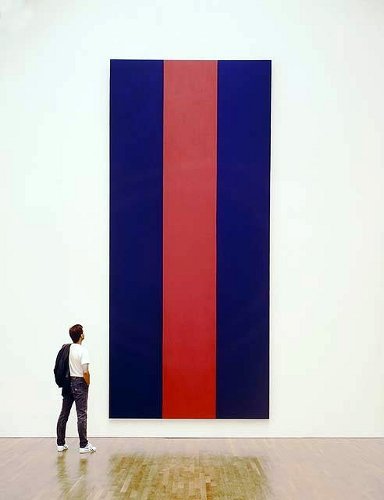
If you missed this moment in Canadian museums news, there was something of an outcry when VOF was purchased in 1989 at a cost of 1.8 million. Many Canadians felt that was a lot of money to pay for a viewing experience comparable to staring at weatherstripping. My sense is that the jury of Canadian taxpayers is still out on the wisdom of this purchase and the NGC party line is to promote VOF as a conservative and altogether prudent purchase of a masterwork from the golden age of American abstraction, one that the NCG was lucky enough to get for a song back before the art market went really nuts. The audience participation tactic the guide used to clinch the deal was to get us to stare at the painting for a long time and then look quickly to a blank patch of wall where, through a retinal quirk that creates the affect of a photo negative, the dark blue bands reverse to the orange of the original and the orange band reverses to the blue of the original. I did this and felt I was participating in a simplified version of the office-time-wasters I used to enjoy in the early days of forwarded e-mail, and whatever the merits of the piece (I think the relation of the bands to the scale, and the relation of the texture to the scale is moderately compelling) it's not the quality I'd use to get sceptics on board, and for my money Newman had jumped the shark by the mid-60s. The NGC has an excellent Newman from a decade earlier that no one much remarks on.
I spent way longer in the Crazy Kitchen at the Museum of Science and Technology than I did looking at VOF. Here's how it works. You stand on a floor that's tilted at a reasonably steep slope. The decor of the kitchen consists of familiar geometric patters, like square tiles and zigzagged right angles and predictable curves. The affect is to tell your brain that you're in a normal balanced environment, and then as soon as you step somewhere you feel dizzy and weirdly balanced and just generally like you'd rather be anywhere that isn't this damn crazy kitchen. I know. It's wacky. That being said I don't for the life of me know what brings all the stuff in the grab bag of science museums together. I believe a good painting from any era has the potential to be appreciated without any particular knowledge of art history or theory, while science is only useful or even enjoyable if you build knowledge of a discipline systematically. This was the one museum where I might have been glad of a tour guide to tell me I was experiencing a breakdown in the dialogue between the eye and the inner ear, or that we we're taught the primacy of geometric absolutes to the detriment of ignoring obvious organic realities. But I'm just rambling here. I'm not a scientist, and I don't feel science museums help make me one.
Don't even ask what camping in a tent 45 minutes North of Central Ottawa is like if all your destinations take place in the city, but that's I was doing. (Keeping myself presentable enough to enter restaurants without being eyed as a potential dine-and-dasher is just the beginning of daily challenges.) There was lots of discussion at our campsite about whether the birds that woke us angrily at 5:00 am were crows or ravens. When I visited the Museum of Nature there was, in the ornithology room, a stuffed crow right next to a stuffed raven, as though this is an Ottawa area FAQ. It was immediately obvious the birds waking us were crows. Now that's a museum display with an immediate application to my daily life.
8. Physicist, philosophers, poets, and management consultants all, in wildly diverse ways, struggle with the question, "How long is a 'now'?" Here's my answer. A 'now' is the length of time it takes to experience all of human endeavour in a single visit to a museum.
9. I'm sure that if I lived in Carp I'd be proud that my town was thought of as the gates of hell, and proud that the metaphor arose from a post-nuclear scenario for saving Federal Government V.I.P.s.
10. The most notorious EGH decommissioning was a bunker in Penhold, Alberta which was sold to a private buyer who was then approached by Hell's Angels to purchase it for a headquarters. Feeling a need to quash a transaction that might corrupt the bedrock (literally) of Canadian society, the Federal Government repurchased it for twice what they'd sold it and then paid to have it destroyed. The remaining de-commissioned bunkers have been dealt with more frugally and just been sealed.
11. Don't we all love those scenes in Hollywood action movies where the hero and girl, in slo-mo, outrun, outdrive or outmotorcyle a fireball pursuing them down a tunnel. (If you're interested mathspig.wordpress.com tells me a fireball moves at about 400m/sec) Can't you just see Prime Minister Diefenbaker and his girl charging down the blast tunnel and slamming closed the door a nanosecond before the fireball hits? It's stirring to think of our national leader in that role, isn't it?
12. Which I love. What I hated about grade school was being forced to sit still and take in the whole event. Honestly, that ruined the parts I would otherwise have found really interesting. I'd have done so much better if I could have wandered in and out of the class at will. Those 40%s would easily have climbed to 55%s.
13. Note that I'm hanging back. Coward that I am, in the event of a nuclear attack I'm sure I'd make every attempt to be the first into deepest recesses of the bunker. I'd probably do an ultimate Lord Jim and push my girl back into the fireball to get ahead. During a tour though, when it would be the wildest cosmic fluke to get trapped in here at the time of an attack, I'm naturally the last to trail into any cavity whose structure looks dark and architecturally iffy. I don't like the idea that the steel door might close on us and Eric might have left his cell phone back in the cafeteria.
14. Now that I think of it, we're talking the 50s and 60s here and a large portion of the population smoked. Cigarettes are the Economics 100 example of an accidental currency arising in contained micro economies like prisons and internment camps. This is because individual cigarettes are small uniform items that can easily be assigned a value. A dynamic arises between smokers who want them and non-smokers who don't want them but will happily trade them for something they do want. Heavily traded cigarettes become worn and useless for smoking and become pure currency for smokers and non-smokers alike. I'd have opted for stockpiling cigarette cartons in this nicely refrigerated zone, rather than gold.
Then in 1966 I'd have offered Barnett Newman 50 cartons of cigarettes from the bunker in exchange for the freshly painted Voice of Fire, a trade I'm sure Newman would have been all over.
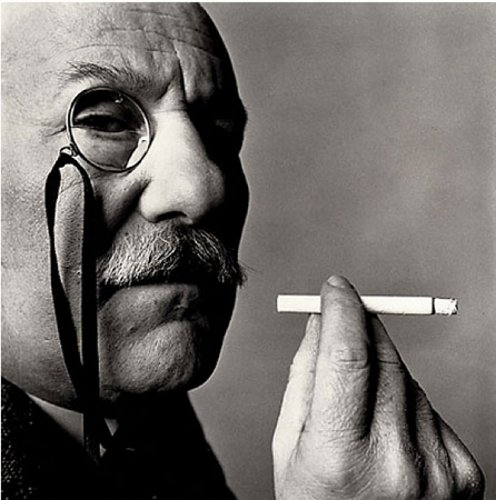
15. Like Doh! That's the point.
By adrian (registered) | Posted October 03, 2010 at 22:29:16
Mississauga Tourist:So what's it like living in Mississauga?
Mississauga Native:It's not bad. It's great having the airport nearby. I guess you could say that's mostly were we go to hang out.
Mississauga Tourist: Really! What do you do there?
Mississauga Native: Well, there are a lot of overpriced restaurants, and lots of places to buy Tylenol and gum, and the people who work security clearance are fun to goof around with. And if you run into friends and you have a few days to kill you can fly somewhere. I always take my passport with me just in case.
Mississauga Tourist: Isn't it hard to get to?
Mississauga Native:Not at all. Sometimes I ride my bike. Mostly I just walk though.
Mississauga Tourist: Wow, do you ever run into people you know there?
Mississauga Native: All the time. I guess you could say it's the heart of the Mississauga community.
That's the funniest thing I have read online in a long time.
You must be logged in to comment.
There are no upcoming events right now.
Why not post one?